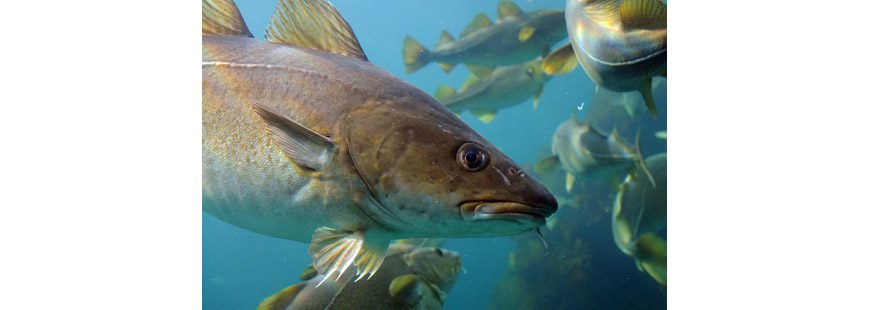Top Photo: Gulf of Maine Atlantic Cod, by Joachim S. Mueller
One of the most frustrating aspects of fisheries management is the fact that two people—or, more often, two groups of people—can look at the same set of facts and come to two very different conclusions.
It’s not unusual for scientists who manage fish stocks to look at a particular population of flounder or snapper or cod, compare its current condition to the population’s historical state, and decide that it’s badly depleted, while fishermen look at the same population and insist that it’s doing well.
Such divergent opinions often lead to bitter conflicts at meetings of regional fishery management councils and other management bodies, as fishermen feel themselves wrongly burdened by unnecessary regulations, while fishery managers insist that additional restrictions are needed to ensure the health of the stock.
Looking at such conflicts from the outside, it can be difficult to understand how two groups of people, both intimately familiar with the fish stock in question, can reach such different conclusions. Recently, a team of researchers conducted a study to determine what underlies such very different perceptions. The results of that study were included in a paper titled “Lost in translation: understanding divergent perspectives on a depleted fish stock,” which was published in the Canadian Journal of Fisheries and Aquatic Sciences.
The researchers found that while scientists and fishermen might look at the same population of fish, they are seeing it through very different lenses.
Their findings evoke memories of the ancient Indian parable of the blind men describing an elephant:
A group of blind men heard that a strange animal, called an elephant, had been brought to the town, but none of them were aware of its shape and form. Out of curiosity, they said, “We must inspect and know it by touch, of which we are capable.” So, they sought it out, and when they found it they groped about it. The first person, whose hand landed on the trunk, said, “This being is like a thick snake.” For another one whose hand reached its ear, it seemed like a kind of fan. As for another person, whose hand was upon its leg, the elephant is a pillar like a tree-trunk. The blind man who placed his hand upon its side said the elephant, “is a wall.” Another who felt its tail, described it as a rope. The last felt its tusk, stating the elephant is that which is hard, smooth and like a spear.
In the same way, the researchers found, scientists and fishermen don’t share the same sources of information, and so come away with differing perceptions of the state of the stock.
Fishery scientists tend to rely on stock assessments, which are generally derived from complex population models, and supported by surveys such as the Northeast Fishery Science Center’s trawl surveys or the industry-based trawl survey conducted by the Massachusetts Department of Marine Fisheries.
Fishermen are most likely to gauge stock health by the number of fish landed, and perhaps more particularly on the number of fish landed compared to the amount of effort expended (landings per unit effort).
The conclusions drawn by both scientists and fishermen are not unreasonable given the information that underlies them, even though they may be substantially different. As the researchers observed, although the fishermen’s perspective “may be subject to significant biases, the scientific community cannot claim ownership of the truth when assessment models provide catch advice that persistently results in overfishing, despite the reported catch remaining within assessment-based catch limits.”
To demonstrate how differing perceptions can affect fishery management, the researchers used the example of Gulf of Maine cod, noting that,
The assessment perspective depicts a stock that has declined for several decades and is currently at 5% of its target population size…Fishery managers have attempted to constrain [fishing mortality] using various regulations, including area closures (1998-present), effort restrictions and trip limits (1997-2009), and annual quotas (2010-present). Unfortunately, these management actions have failed to prevent overfishing every year since 1981, even though the fishery routinely harvests within the limits set by stock assessments…Increasingly restrictive regulations and stock rebuilding failures have caused severe social, emotional, and economic harm among the fishing community. Fisher distrust in science-based fishery management is high, and industry groups routinely oppose any new conservation measures…The influence of constantly shifting regulations on catch rates has led to fishery-dependent indices being removed from the stock assessment, diminishing fishery confidence that they have a voice in the management process. Significant misreporting of catch has eroded trust in the primary assessment data sources. In short, both the biological and social capital of this system are severely depleted.
Their research is intended to determine why fishermen’s faith in the system has deteriorated so badly.
The researchers began by interviewing 130 commercial fishing boat captains and asking whether they believed that the Gulf of Maine cod population had increased, decreased, or remained the same over the past 10 years. Ninety-four of the captains contacted provided a response, with 63% of them saying that the cod population had increased, and 44% saying that the population had increased “a lot.” Only 24% said that the population had decreased, while 13% believed that it had remained the same.
Most of the captains’ responses conflicted with the findings of scientists at the National Marine Fisheries Service (NMFS), which has determined that the cod’s spawning stock biomass has been shrinking for decades. Massachusetts’ industry-based trawl survey essentially confirmed NMFS’ scientists’ findings.
That might not have surprised the researchers, who found that the captains who believed that the cod population was increasing had less faith in NMFS’ Northeast Fisheries Science Center and in local government than did those who felt that the population was declining or holding steady. Their paper noted that such distrust “could be the result of another unintended cognitive influence, known as confirmation bias, or the tendency to interpret new information in a way that supports previously held beliefs. In other words, distrust earned from several years of inconsistent and uncertain assessment results likely caused some fishermen to categorically disbelieve the repeated scientific determination of severe depletion, even as their own catch rates began to decline. [citations omitted]”
As the researchers began to investigate why fishermen’s perceptions of stock health differed so much from the scientific consensus, they found that the relationship between harvest limits and catch rates played a significant role. For example, during the years 1994 through 2010, regulators attempted to control fishermen’s landings by limiting the number of days on which they could fish. Landings were also constrained by limiting the amount of cod that fishermen could harvest each day, but that created another problem, as fishermen were being forced to discard some portion of their catch at sea to avoid exceeding the daily landings limit.
To minimize the number of dead discards at a time when the cod population continued to decline, regulators significantly reduced the number of days at sea allotted to each fishing vessel, but increased the daily trip limit, so that a greater percentage of each day’s catch could be landed. At the time that change was made, most of the remaining cod were found close to shore, and the price that fishermen received for their catch was increasing. The combination of increased daily limits, high market price, and cod being found close to shore made cod a desirable target for the commercial fleet, caused catch rates to increase at the same time that the overall cod population declined, and created a perception among many fishermen that cod were more plentiful than indicated by the stock assessments.
As the paper explained,
Fishers acquire extensive ecological knowledge through daily direct observations of catch rates, and they are often acutely aware of spawning grounds, trophic interactions, and shifting spatio-temporal distributions. Recognizing these patterns is essential to the success of a fishing captain, and the tactical decisions of where to deploy their gear integrates this ecological knowledge within the complex array of regulations. Fisher ecological knowledge also accumulates over generations…[and] is also what enables captains to target a species and fill their harvest limit (either daily or annual) even as the stock declines. [citations omitted]
Fishermen’s continuing ability to fill their harvest limits, even as daily landings limits increased, made it difficult for them to perceive that the stock was in any sort of trouble.
Such perceptions continued even after regulators adopted new rules in 2015, which cut the annual catch limit by 95% (compared to 2010) and caused the catch rate to sharply decline. That would seem contrary to the researchers’ hypothesis that catch rates drive fishermen’s perceptions, but they explain the seeming conflict by calling the regulations adopted in 2015 “the greatest disruption to fishing effort in the history of the fishery,” and by observing that
Captains had to adapt to fishing in new times/areas and transition away from targeting cod to avoiding the species. As such, it may have taken additional time for fishers to form new opinions on the cod population that differed from their previous experiences. Furthermore, a series of management actions…closed nearly all the known cod spawning ground to fishing, and the resultant redistribution of fishing effort shifted the size selectivity of the fishery toward smaller fish. Fishers generally recognize that their catch of large cod had been curtailed by these actions and likely do not appreciate the significant loss of older fish in the population. In addition, the decline in juvenile recruitment is essentially undetectable to the fishery, given the large regulated minimum mesh (16.5 cm) and hook (12/0 circle) sizes. The decline in medium-sized fish…has been less than for large and sub-legal cod, and a reduction in the minimum fish size…has allowed for more of these fish to be landed. These layers of fishing regulations influence how captains observe the fish population and should be acknowledged when interpreting fisher perspectives.
Thus, the regulations effectively isolated fishermen from the evidence most likely to convince them that such restrictive management measures were actually needed.
The researchers also found that fishermen who are in financial distress are more likely to perceive the cod population to be thriving, a phenomenon that is probably attributable to the current management plan, which assigns “catch shares,” or a unique annual quota, to each vessel in the fishery, and prohibits vessels from discarding any legal-sized cod. If a vessel exceeds its share of the catch, it must purchase enough quota from another fisherman to cover the overage, and the price for that extra quota is often more than the market price paid for the cod. Thus, as the researchers explained, “large catches of cod went from having positive associations (i.e., increased revenue) to negative associations (i.e., increased costs)…which likely affected perceptions of trend.”
Regardless of cause, it is clear that fishermen’s perspectives matter. The differing perspectives of fishermen and fisheries scientists create an obstacle to effective management. The researchers observed that “a discrepancy between stakeholder perspectives because of the lack of a shared knowledge base inhibits consensus building in management. Translating between the perspectives of the scientific and fishing communities helps both groups recognize the common signal that underlies these disparate sets of observations.”
The paper did not shield either the fishermen or the scientists from their share of the blame for the problems besetting Gulf of Maine cod, concluding that “divergent perspectives on stock status still represent a major challenge to fishery management. The management community should recognize that fishery misconceptions about population status are due in large part to the effect of regulations and a distrust of inconsistent assessment results.”
Still, the paper closed on a somewhat hopeful note, observing that, while divergent perspectives might always be a part of the fisheries management process, an understanding of why such divergence occurs may help to avoid stakeholder conflict.
And any avoidance of conflict can only help the process succeed.



Another excellent article by the master!
The researchers also found that fishermen who are in financial distress are more likely to perceive the cod population to be thriving, a phenomenon that is probably attributable to the current management plan, which assigns “catch shares,” or a unique annual quota, to each vessel in the fishery, and prohibits vessels from discarding any legal-sized cod. If a vessel exceeds its share of the catch, it must purchase enough quota from another fisherman to cover the overage, and the price for that extra quota is often more than the market price paid for the cod. Thus, as the researchers explained, “large catches of cod went from having positive associations (i.e., increased revenue) to negative associations (i.e., increased costs)…which likely affected perceptions of trend.”